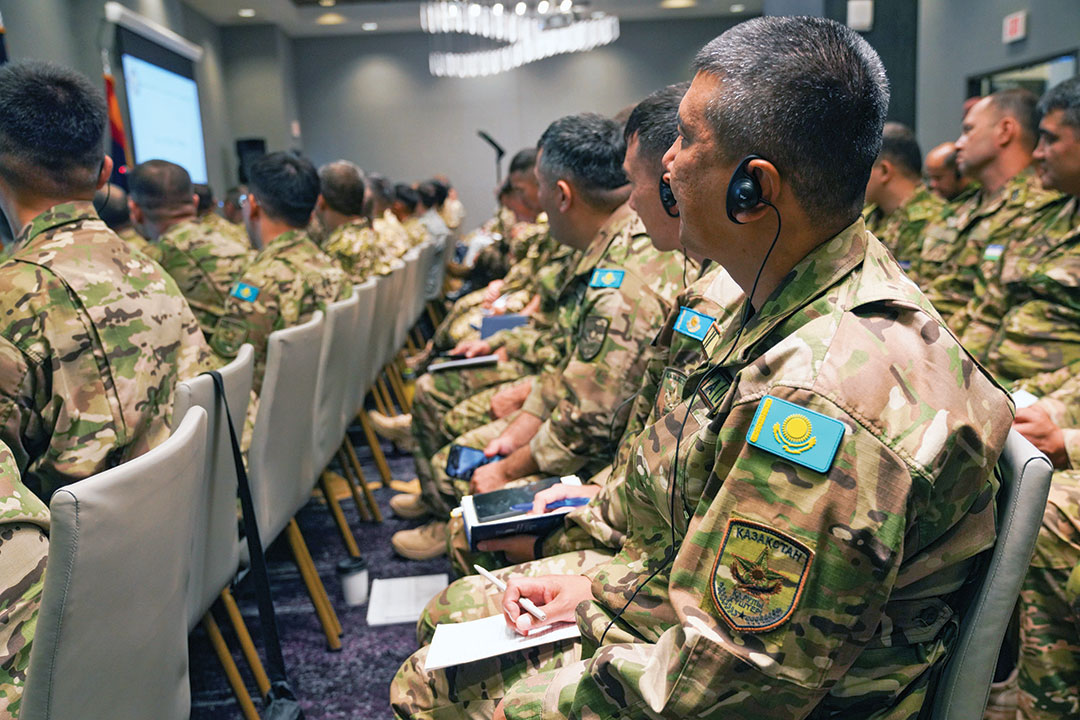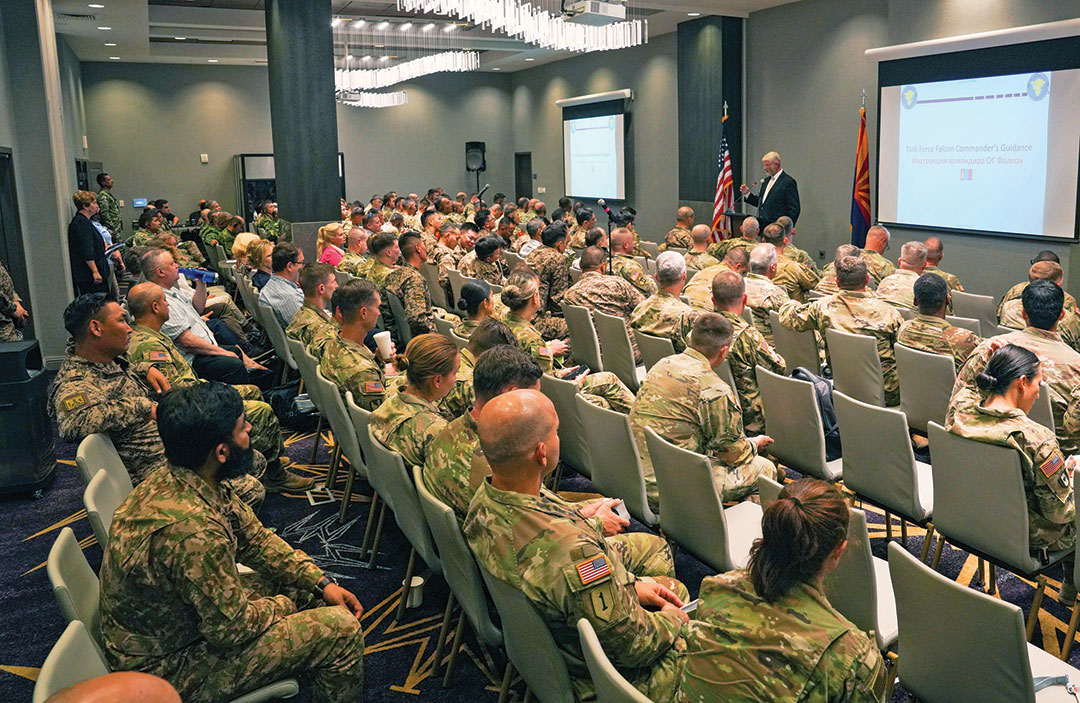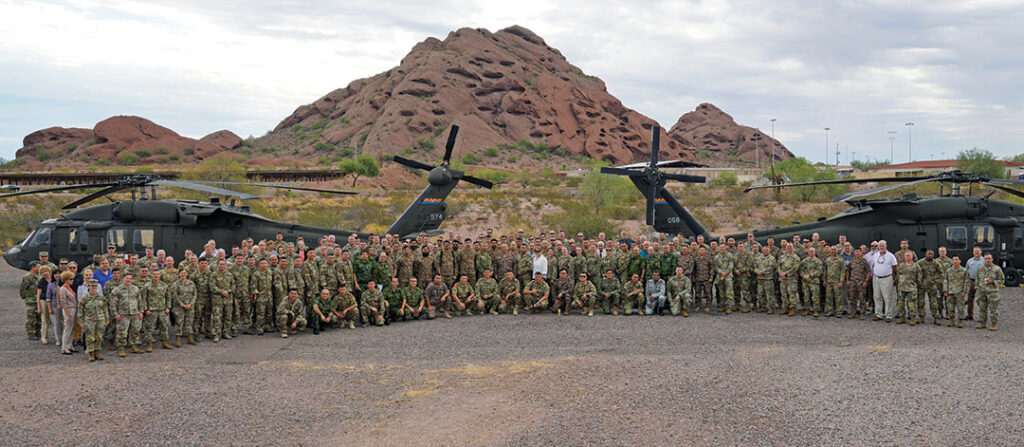Photos by TECH SGT. DANIEL ROBLES/U.S. AIR FORCE
The nation of Red Land, conspiring to reassemble its former empire that had disintegrated 30 years earlier, hires mercenaries to harass one of its former satellite states called Blue Land.
Alarmed when the Red Land proxies cross the international border and occupy a stretch of Blue Land territory, the United Nations Security Council summons a multinational military coalition to protect citizens of Blue Land and, if necessary, expel Red Land-backed forces.
The peacekeeping duty falls to task forces consisting of troops from Kazakhstan, the Kyrgyz Republic, Mongolia, Pakistan, Tajikistan, Uzbekistan and the United States. Senior officers from these countries coalesce into a headquarters staff to direct operations in defense of Blue Land’s sovereignty.
Regional Cooperation 24, a command post exercise organized by U.S. Central Command in August 2024, presented this fictional scenario should forces encounter similar events in the world.

“The main purpose is expanding knowledge of current threats to national security in the world and preparing to react to crises,” said Uzbek Col. Rasuljon Djaparov. “CENTCOM gives us a wonderful platform to work with our partners and friends and share our knowledge.”
Col. Djaparov served on a team of senior officers that shaped scenarios for the 250 multinational exercise participants in Phoenix, Arizona, in the U.S. With the aid of interpreters, staff officers performed functions such as intelligence gathering, planning, logistics and operations using interconnected computers.
As a cascade of simulated crises descended on the training audience, troops needed to be resourceful, organized and communicative to succeed.
Occupying the role of the combined joint task force commander was Mongolian Col. Batzaya Odsuren. A special operations and artillery officer in real life, Col. Odsuren was qualified for the role: He is a veteran of five multinational peacekeeping and stability missions in places such as Iraq, Afghanistan, South Sudan and the Democratic Republic of the Congo.
His pointed questions to his subordinates at Regional Cooperation indicated a deep familiarity with the requirements of stability operations.
Were his troops protecting women and children inside displaced persons camps? Had his troops conducted media campaigns to gain support from civilians? Were his battalions shielding a critically important hydroelectric dam against attacks from the enemy?
“This is the 10th time Mongolia has sent troops to Regional Cooperation,” Col. Odsuren said from his command cell. “It’s sometimes a challenge to communicate with Soldiers from other countries, but it provides important benefits for Mongolians to get lessons in real-world situations and tactics.”

The Soldiers acting as staff officers were urged to be alert and attentive and to report unusual events up the chain of command. Those who didn’t earned mild reprimands.
“Miscommunication will occur. There’s no way it cannot occur,” one U.S. officer told his multinational team. “But commanders need to know if something appears out of order.”
Unusual for Regional Cooperation since its beginnings in 2001, the 2024 exercise readied staff officers for offensive operations to neutralize enemy forces that crossed the border into friendly territory. The U.N. mandate under which the fictional task force operated specified that mercenaries were not afforded special protection as enemy combatants.
“You are always preparing for the worst-case scenario, and the worst-case scenario is war,” said Anthony Lieto, of the Peacekeeping and Stability Operations Institute of the U.S. Army War College, who helped craft the simulations used in Regional Cooperation 24.
“But stability operations and peacekeeping still represented the majority of missions. This exercise has a little bit of everything.”
Col. Samat Seidaliev, a divisional commander from the Kyrgyz Republic, viewed Regional Cooperation as preparation for crises that require responses from a multinational coalition.
“We learn to interact and coordinate with the other countries in the exercise,” Col. Seidaliev said. “With special operations forces, for example, each country has its own vision, but here we’re able to focus on a single vision and make it our own.”
Another valuable component of Regional Cooperation was the pairing of Central Asian and Mongolian troops with counterparts from the U.S. National Guard State Partnership Program. The program coordinates military exchanges between U.S. Soldiers and those from partner nations.
The pairings are Kazakhstan with the Arizona National Guard, the Kyrgyz Republic with the Montana National Guard, Mongolia with the Alaska National Guard, Tajikistan with the Virginia National Guard and Uzbekistan with the Mississippi National Guard.
“Our military personally receives experiences they can apply in the real world,” Kazakhstan Col. Yermek Abdrakhmanov said of the multinational environment at Regional Cooperation. “The Kazakh military is different from the U.S. military, and we learn from each other.”
Pakistan typically sends a senior commander to Regional Cooperation, and the 2024 exercise was no exception. Brig. Gen. Atif Ejaz, director of training at Pakistan’s Joint Staff Headquarters, was head of delegation for 14 officers from the Pakistani Army and Navy.
“We want to keep good relations with the U.S. And since the Central Asian republics came into being, we’ve had good military-to-military relations with them as well,” he said.
Brig. Gen. Atif served as deputy commander, under Col. Odsuren, of the combined joint task force at Regional Cooperation.
“We believe in the core objectives of the exercise such as interoperability, and we learn from each other’s best practices,” the brigadier general said. “Sustainment and media warfare also play significant roles.”
Regional Cooperation is U.S. Central Command’s premier multinational peacekeeping exercise with its Central Asian partners. It runs for about two weeks, and typically shifts locations each year. Kazakhstan, the Kyrgyz Republic and Tajikistan have hosted past exercises.

